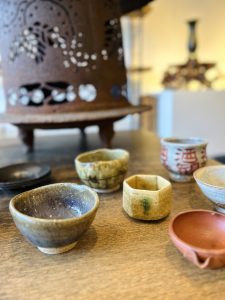酒器選びを楽しんでみませんか(愛知県名古屋市千種区姫池通 骨董買取 古美術風光舎)
2024.01.27
皆さまこんにちは。スタッフHでございます。
今日の名古屋は少し気温が高く、温かい日差しにほっとしています。寒さ対策という訳ではないのですが、年始にいただいた日本酒を毎晩少しずつ飲んでいます。寒い日は体の芯から温まる気がして夕食時の楽しみとなっています。アルコールは控えようと努めていたのですが、頂き物を無駄にするのは勿体ないし、百薬の長とも言うしなど都合の良い理由を重ねております。
さてお酒をいただく器にはお猪口やぐい呑みがありますが、私はとちらも同じようなものと認識しておりました。気になり調べてみると一定の区別があるようです。

ぐい呑みの方が底が深く口径もやや広く作られており、何口かに分けて飲み干すのに対し、お猪口は一口で飲み干すことができるものということです。具体的に何センチ以上はぐい呑みというような定義があるわけではないようですが、一口で飲み干せるかどうかが目安となっているようです。
お酌をする文化がある日本では、お酒を勧められたら器を開けることが礼儀とされることがあります。この文化は戦国時代にも存在していたらしく、一口で飲み干せるサイズのお猪口が活躍していました。そのため宴席ではお猪口が使われることが多かったようです。
お猪口で思い浮かぶ模様といえば、内側が白く底に二重の青い円が描かれている「蛇の目(じゃのめ)」でしょうか。文字通りヘビの目に見えることからきています。
元々利き酒用に作られた酒器なのだとか。日本酒は一見すると透明に見えますが、実際には少し黄味がかった色をしています。その理由として原料となる米の成分や、糖とアミノ酸が引き起こす反応によるもので、熟成が進むとともに色味が強くなっていくそうです。
その色味を引き立たせるのが黄色の反対色である青色。このように日本酒の色味や透明度を分かりやすく見せるための演出として蛇の目が使われるようになったとのことです。
一方ぐい呑みは、ぐいぐい飲める、ぐいっと持って飲むという意味合いで名づけられたと言われています。満足な量のお酒を、自分のペースで楽しむことができます。
今では酒器の一つとして使われているぐい呑みですが、昔は茶事で向付(むこうづけ)として「このわた」や「なます」などの珍味をいれる器として使われていたそうです。そして食べて空いた器にお酒を入れて飲んだことが、ぐい呑みの始まりと言われています。
またその容量の差からお猪口とぐい呑みでは味や香りが変わるといいます。
お猪口は一口で飲めるサイズなので、冷酒や熱燗の温度が変わることがなく、この温度で飲むのが美味しいという日本酒を飲む時に向いています。
ぐい呑みは何口かに分けて飲むため、冷酒が常温に近づいていき、熱燗もぬる燗から常温に向かっていきます。その間に辛さや甘さ、香りの立ち方や酸味の強さなども変化するそうです。純米酒は温度によって異なる米の旨味やコクを味わえるため、ぐい呑みの方が楽しめるとのこと。
更にガラス、錫、陶磁器、漆器などの素材によっても味が変わってくるそうですから人間の感覚というのは繊細にできていますね。個人的には好きな器で飲む!というのも精神的、脳科学的に良いのではと感じています。
いずれにせよ飲み過ぎないよう程々にいたします。
それでは、またお会いしましょう。
Hello everyone. This is Staff H.
It is a little warmer in Nagoya today, and I am relieved to see the sun shining. Although it is not a countermeasure against the cold, I have been drinking a little sake every night, which I received at the beginning of the year. On cold days, it warms me from the inside out, and I look forward to it with pleasure at dinner. I have been trying to refrain from drinking alcohol, but I have come up with a number of convenient reasons, including the fact that it would be a shame to waste what we have received and that it is the best of all medicines.
I had always thought of sake drinking utensils as being the same thing, such as the inoguchi (cup) and guginomi (sake cup). However, when I looked into it, I found that there is a certain distinction between the two.
Guinomi has a deeper bottom and a slightly wider diameter, and is meant to be drunk in several sips, whereas ochoko is meant to be drunk in one gulp. There is no specific definition of “gûinomi” in terms of the size of the cup, but it seems to be based on whether or not it can be finished in a single gulp.
In Japan, where the culture of pouring sake is practiced, it is sometimes considered polite to open the cup when offered alcohol. This culture seems to have existed even in the Warring States period, and an ochoko (a small sake cup) sized to be consumed in a single gulp was in use. Therefore, it seems that ochoko was often used at banquets.
The pattern that comes to mind when thinking of boar cups is “janome,” which is white on the inside and has a double blue circle on the bottom. The name “janome” comes from the fact that it literally looks like a snake’s eye.
It is said that this sake cup was originally made for sake tasting. Sake looks transparent at first glance, but in reality it has a slightly yellowish color. The reason for this is due to the components of the rice used as the raw material and the reaction caused by sugar and amino acids, and the color becomes stronger as the sake matures.
The color is enhanced by blue, the opposite of yellow. Thus, snake eyes came to be used to show the color and clarity of sake in an easy-to-understand manner.
Guinomi, on the other hand, is said to have been named after the meaning of being able to drink sake in a gulp or holding it gulpingly. It allows you to enjoy a satisfying amount of sake at your own pace.Today, guinomi is used as a drinking vessel, but in the old days, it was used as a mukozuke, a vessel to hold delicacies such as konowata and namasu at tea ceremonies. It is said that the first gûinomi was used for drinking sake in the empty cups.
The difference in capacity is said to be the difference in taste and aroma between an ochoko and a guinomi.
Since an ochoko is sized to be drunk in one gulp, it is suitable for drinking sake that tastes best at this temperature, without changing the temperature of cold or hot sake.
Because the guinomi is divided into several sips, cold sake approaches room temperature, and hot sake moves from lukewarm to room temperature. During this time, the spiciness and sweetness, the way the aroma rises and the strength of the acidity also change. Junmai sake can be enjoyed more in a guinomi because the flavor and richness of the rice can be tasted at different temperatures.
Furthermore, the taste is said to change depending on the material used, such as glass, tin, ceramic, or lacquerware, so the human senses are very sensitive. Personally, I like to drink from my favorite cup! I personally feel that drinking from the vessel of your choice is also good for your mentality and brain science.
In any case, I will drink in moderation so as not to overdo it.
See you again soon.
*******************
ご実家の整理やお片付けなどをされている方のご相談などが多くございます。
お片付けなどくれぐれもご無理のないようになさってくださいませ。
風光舎では古美術品や骨董品の他にも絵画や宝石、趣味のお品など様々なジャンルのものを買受しております。
お片付けをされていて、こういうものでもいいのかしらと迷われているものでも、どうぞお気軽にご相談下さいませ。
また風光舎は、出張買取も強化しております。ご近所はもちろん、愛知県内、岐阜県、三重県その他の県へも出張いたします。
まずは、お電話お待ちしております。
愛知県名古屋市千種区姫池通
骨董 買取
【古美術 風光舎 名古屋店】
TEL052(734)8444
10:00-18:00 OPEN

